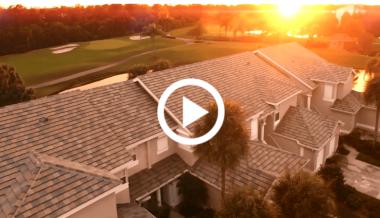Signs You Need Roof Repair in Florida’s Rainy Season
Rainy season is upon us, and you know what that means - afternoon thunderstorms. From May to October, our rainy season becomes particularly intense. It's a time of year that can soak communities from Tampa Bay to Marco Island in more than 40 inches of rain.
While the afternoon thunderstorms may seem like business as usual, that much water can quickly expose weaknesses in your roof, especially if it's already nearing the end of its life or hasn't been well-maintained. For property managers, HOAs, and building owners, an issue left unaddressed today can become a serious leak tomorrow - resulting in costly damages, construction repairs, and even litigation if not addressed in a timely manner.
Proactively catching potential issues is critical, whether you’re in a condominium community, commercial building or single family home. Here are 4 signs your roof may need repairs and why addressing them before peak storm activity ramps up could save you serious time, money, and disruption.
1. Water Stains on Ceilings or Walls
Brown spots or streaks inside your units or common areas are an obvious sign from the interior of a unit that there’s a problem. These are signs of a potential leak that’s already made its way past the roofing system and into the structure. Whether the issue comes from poorly maintained and aging roofs or pooling on a low-slope or flat roof, water from summer storms can find the smallest entry point. If you’re seeing stains, it should not be ignored and needs to be addressed immediately.
2. Sagging or Bubbling on Flat Roofs
For commercial and multi-family buildings especially, sagging or blistering in the roofing membrane can indicate trapped moisture, delamination, or structural stress. These problems only worsen under Florida’s heat and pressure from standing water. It's critical to address this before daily rainfall becomes the norm.
3. Missing or Damaged Shingles or Tiles
Even without a hurricane, Florida’s intense summer storms (and even recently tornadoes) bring gusty winds that can dislodge shingles, crack tiles, or lift roof flashing. Once that outer barrier is compromised, water intrusion is often just a matter of time. Inspections completed annually helps ensure that any surface-level damage can be mitigated in a reasonable timeframe.
4. Granules or Debris in Gutters and Around Downspouts
If you or your maintenance team notices roofing material in the gutters, it may be a sign your roof’s protective layer is deteriorating. This is particularly true for asphalt shingle roofs, which lose granules as they age or take wind damage. On the West Coast of Florida, where coastal breezes and salt air accelerate wear, this is another indicator that your roof needs attention.
5. Don't Wait for the Leak
In Florida, we don’t get to pick and choose when the next storm rolls in. Being proactive about roof maintenance - especially when these warning signs appear - can protect your budget, your property, and your peace of mind all season long.
Ready to schedule roof maintenance to protect your roof through storm season?
Our experienced team works with property managers, HOAs, and building owners to prioritize repairs, extend roof life, and keep your investment protected.
.jpg)

.png)

